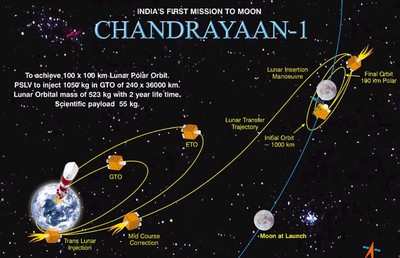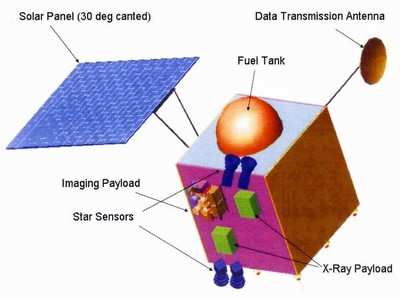Tue, Jun 28, 2005
Mission Slated For 2007 or 2008
 When India launches its first-ever
unmanned moon mission, it will carry payloads for the European
Space Agency and NASA, according to the country's space agency.
When India launches its first-ever
unmanned moon mission, it will carry payloads for the European
Space Agency and NASA, according to the country's space agency.
“The payload from ESA that would weigh 30 kg will include
a multi-spectrometer and a particle detector,” Indian
Satellite Research Organization (ISRO) chairman Dr. G. Madhavan
Nair told reporters at an international conferences on Planetary
Exploration and Space Law. He was speaking in Bangalore, India.
“ISRO has already received a number of proposals from
international agencies including NASA. Deliberations are on and the
payload will be finalized shortly,” he said.

The ESA will contribute to the mission:
- A low energy (0.5-10 keV) X-ray spectrometer called Chandrayaan
Imaging X-Ray Spectrometer from Rutherford Appleton Laboratory, UK,
to measure elemental abundance distributed over the lunar surface
using X-ray fluorescence technique. It will also include X-ray
solar monitor to record the incident solar X-ray flux.
- Near Infra-Red (IR) Spectrometer from Max Planck Institute of
Aeronomie, Germany, to detect and measure lunar mineral
abundances.
- Sub keV Atom Reflecting Analyzer from Swedish Institute of
Space Physics, developed in collaboration with India, to measure
volatiles generated due to solar wind impacting on lunar surface
and determine the surface magnetic field anomalies.
- Europe will also contribute to the Indian experiment, namely,
High Energy X-ray Spectrometer.
The European instruments will complement the following main
Indian experiments on Chandrayaan-1:
- Terrain Mapping Camera with stereo imaging capability operating
in panchromatic band with 5 meter spatial resolution and 20 km
swath.
- A Hyper-Spectral Imager operating in 400-900 nm band with a
spectral resolution of 15 nm, a spatial resolution of 80 meter and
20 km swath.
- A Lunar Laser Ranging Instrument with a vertical resolution of
better than 5 meter.
- A High Energy X-ray (10-250 keV) spectrometer with a footprint
of 20 km to detect radio nuclei.
- In addition, an Impact Probe has been included in the mission
for proving technological elements required for future landing
missions.

Chandrayaan-1 is planned for launch by 2007-08 on board India's
Polar Satellite Launch Vehicle. The 525 kg satellite will be placed
in 100 km polar orbit around the moon and it will have a life time
of two years.
More News
Also: Netherlands Donates 18 F16s, 2 737s Collide On Ramp, E-7 Wedgetail Cut, AgEagle's 100th In S Korea The Pilot and Aircraft Privacy Act was introduced in the House by Represent>[...]
Pilot Also Reported That Due To A Fuel Leak, The Auxiliary Fuel Tanks Were Not Used On June 4, 2025, at 13:41 eastern daylight time, a Piper PA-23, N2109P, was substantially damage>[...]
Have A Story That NEEDS To Be Featured On Aero-News? Here’s How To Submit A Story To Our Team Some of the greatest new stories ANN has ever covered have been submitted by our>[...]
From 2023 (YouTube Edition): Reflections on War’s Collective Lessons and Cyclical Nature The exigencies of war ought be colorblind. Inane social-constructs the likes of racis>[...]
What Goes Around, May Yet Come Back Around, Klyde FMI: www.klydemorris.com>[...]
 Airborne 06.30.25: US v ADS-B Misuse, Natl STOL Fire, Volocopter Resumes
Airborne 06.30.25: US v ADS-B Misuse, Natl STOL Fire, Volocopter Resumes NTSB Prelim: Piper PA-23
NTSB Prelim: Piper PA-23 ANN FAQ: Submit a News Story!
ANN FAQ: Submit a News Story! Classic Aero-TV: One Mans Vietnam
Classic Aero-TV: One Mans Vietnam Klyde Morris (06.30.25)
Klyde Morris (06.30.25)





